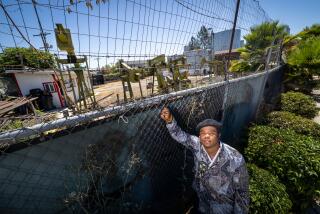Girls track breast cancer puzzle
- Share via
The science fair poster on the floor in Sarah Waliany’s living room in Arcadia has an arts-and-crafts element to it. Glittery pipe cleaners, green and red, are bent to resemble gene strands, while blobs of gold and red glue represent cells.
“I couldn’t get the breast tumor cells to stop clumping together,” Sarah, 16, said, referring to the red cotton balls attached elsewhere to the poster board.
Its homemade texture, combined with the erratic bursts of color, makes it easy to mistake the poster for a simple science fair project. In reality, several medical researchers say, the results presented on the fluorescent paper could have important implications in understanding why some breast cancers are drug-resistant.
Sarah, who has been working on this research for precisely “20 and a half months,” will showcase her work in front of a national audience Dec. 2, when she and her cousin and research partner, Shelina Kurwa, 17, fly to New York as finalists in the Siemens Competition in Math, Science & Technology. Sarah did the lab work, while Shelina anchored the literature research and helped develop the theory behind their project.
The competition, sponsored by the Siemens Foundation (whose parent company is Siemens AG, the engineering conglomerate) and the College Board, attracted 1,641 submissions by high school students across the country. Sarah and Shelina won the regional competition at Caltech on Nov. 10.
Sarkis Mazmanian, an assistant professor of biology at Caltech, was the lead judge on the 10-person panel that reviewed Sarah and Shelina’s project and unanimously gave it first prize. He called the girls’ research “novel and creative” and said it was graduate-level work.
“We were impressed with how clear it was that the girls were the driving force in this research,” Mazmanian said. “That is exceedingly impressive for a student at any age.”
Some of the girls’ precociousness may be a result of their upbringing. Shelina is the daughter of an ophthalmologist; Sarah’s father is an oncologist, her mother a cell biologist.
“Science has been second nature to me -- in the car, we didn’t sing songs, we learned about anatomy,” Shelina said.
This is not the cousins’ first foray into a major science competition together. In 2005, they were Siemens regional semifinalists for their attempt to infuse lettuce -- grown in Sarah’s backyard -- with vitamin C.
This year’s project has clear clinical implications, the judges said. Both Shelina and Sarah say they were motivated to work in breast cancer research after several friends’ mothers were diagnosed with the disease.
“This happens to all children of physicians, who are exposed to very sick patients,” said Dr. Bud Kurwa, Shelina’s father. “They generate questions: ‘How does this happen? What can I do?’ And they realize science is the means to answering these questions.”
Sarah sought to answer a perplexing question: Why do some breast cancer patients develop resistance to the cancer drug Herceptin? She began her work nearly two years ago when she started an internship at the Beckman Research Institute at the City of Hope in Duarte. Her mentor there, Susan E. Kane, a cancer researcher and associate director of the institute, said Sarah applied for the internship when she was 14 -- an unusually young age -- and had to wait until she turned 15 to start work.
“I quickly realized she was smarter than I am,” Kane said.
Sarah’s work in the lab indicates that in the types of breast cancer that Herceptin treats -- 25% to 30% of breast cancer diagnoses, by Kane’s estimate -- a gene strand called t-Darpp causes resistance to the drug.
Shelina’s investigation of literature on the subject added to the conclusions Sarah drew from her lab results.
According to Kane, 70% of women treated with Herceptin do not respond to the drug. Knowing which gene strand causes this resistance “will save precious time and materials.”
Sarah and Shelina seem excited but not overwhelmed by the implications of their research. They do, after all, have other interests.
Shelina founded a Renaissance Club at Westridge School for Girls in Pasadena, writes fantasy stories, designs websites, and recently guest-edited a health feature for Seventeen magazine.
“I’m kind of a Renaissance girl,” Shelina said, comparing her varied interests to Leonardo da Vinci’s many skills. She hopes to be at Yale next fall.
Sarah, a junior, edits the Flintridge Preparatory School’s student newspaper and founded a science journal there. She also volunteers at the San Gabriel Hospital’s children’s ward.
When Sarah deadpanned, “I dream of t-Darpp every day,” it was not immediately clear whether she was joking. She says that though her ultimate goal is to be a physician-researcher, she would choose to be a doctor first. “I’d like to really have patient contact,” Sarah said.
For now, though, the girls jokingly admit they get tired of each other “maybe a little” (they live a few blocks apart). Neither has a boyfriend right now. Sarah said her parents “would probably explode” -- prompting a big laugh from her mother -- while Shelina said, “I’ll have time for that in college.”
And they have other teenage concerns. Sarah doesn’t yet drive and hasn’t had time to prepare for the test. She’s been in the lab.
--






